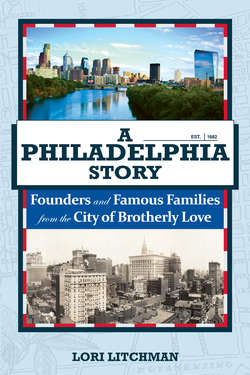Читать книгу A Philadelphia Story - Lori Litchman - Страница 9
На сайте Литреса книга снята с продажи.
CHAPTER 1 THE “HOLY EXPERIMENT”
ОглавлениеWILLIAM PENN WATCHES OVER PHILADELPHIA DAILY. From high atop Philadelphia’s City Hall, his countenance gazes peacefully over his beloved city, his “greene countrie towne,” his City of Brotherly Love. When sports teams do well, William Penn celebrates by donning the jersey or hat of the winning team. But don’t make him mad, or he’ll curse the city and its sports teams.
Penn might be, quite arguably, the most well-known founder of an American city. Ask anyone to tell you who founded Chicago, Boston, or even New York City. Chances are the answer will not come anywhere nearly as quickly as it does in response to the question of who founded Philadelphia. Although Penn didn’t spend very much time in his adopted home, his influence is everywhere—from the city’s structure to the laws that govern our nation.
A Monumental Presence
High atop Philadelphia’s City Hall stands the statue of William Penn. Weighing in at 27 tons of bronze, this 37-foot-tall presence can’t be missed. City Hall was the tallest building in the world from 1901 to 1909, and for decades, not a single building rose above the hat of Philly’s founder.
Penn stands proudly above his city, holding Pennsylvania’s charter in his left hand. After a display of two years in City Hall’s courtyard, Penn was lifted up to his final perch.
Alexander Milne Calder’s statue of William Penn before it moved to the top of City Hall
(Photo: The British Library via Wikimedia Commons, public domain)
Sculptor Alexander Milne Calder designed the statue. He intended the sculpture to face south so the sun would naturally light the statue for most of the day. However, one of the building’s architects decided that Penn should face to the northeast. There are several theories as to why. Some say he is facing Penn Treaty Park—the location of his treaty with the Native Americans. Others say he is facing his country home, Pennsbury Manor, in Bucks County. Regardless, Penn has been overseeing his city since 1894.
William Penn at age 22
(Painting attributed to Sir Peter Lely; via Wikimedia Commons, public domain)
The story of the founding of Pennsylvania, and ultimately Philadelphia, began thousands of miles away in England. King Charles II owed Penn’s father, Admiral Sir William Penn, a great debt for his participation in the English Civil War. Philadelphia’s William was the only son of the admiral, and early in life, the younger Penn was a rebel, causing his father great concern. After Penn was kicked out of Oxford, his father sent him packing.
In his early 20s, the younger William joined a fanatical religious group that was causing a ruckus throughout the United Kingdom. Members of the Religious Society of Friends were often subject to hangings and imprisonment. In 1680, Penn petitioned the king to request a colony in America between New York and Maryland. Penn wanted a place where he and his fellow Quakers could live without fear of persecution. The king saw the granting of Penn’s request as a good way to settle the debt the crown owed Admiral Penn, who was dead at that point. The king gave the younger Penn 45,000 square miles of land, which Penn hoped to call New Wales. The king rejected Penn’s choice for a name, so Penn came up with the name Sylvania (Latin for “woodsy place”). The king liked it, but he insisted Penn’s name be attached to it as well, in honor of the senior William. So the new colony would be called Pennsylvania. As his Quaker faith emphasized personal humility, Penn tried (to no avail) to remove his name from his new colony because he didn’t want his friends to think he was vain.
Penn received the king’s charter in 1681, which stated that Penn would pay the crown “rent” each year in the form of two beaver skins. Penn also promised to give the king 20 percent of any silver or gold found in the new colony, which would eventually amount to nothing. Penn saw Pennsylvania as his “Holy Experiment” and believed his colony would be a place where people could embrace their Quaker ideals.
The king allowed Penn to name his capital city, and so he did. He named it Philadelphia, Greek for “City of Brotherly Love.” He landed in New Castle, Delaware, on October 27, 1682, and headed to his new home.
